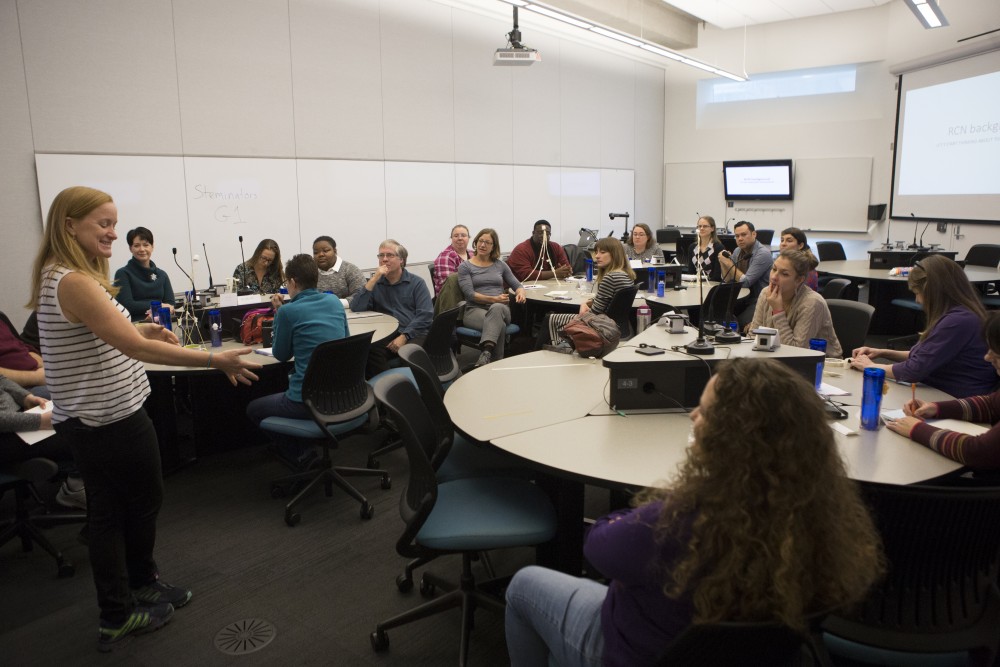More than 20 biology instructors from universities across the country gathered at the University of Minnesota Saturday to brainstorm solutions to inequity in science, technology, engineering and math.
Faculty in the University’s College of Biological Sciences are spearheading an effort to increase diversity in STEM classrooms across the U.S through a group called EDU-STEM. The group met for the first time this weekend, with the goal of finding strategies to implement at their specific campuses.
The program emanated from CBS professor Sehoya Cotner and Postdoctoral Associate Cissy Ballen’s research on the underrepresentation of women and minority groups in STEM over the course of several years.
“We’re interested in some of these gaps because many of them seem… like they’re things we could actually minimize or eliminate with some better curricular choices,” Cotner said.
Cotner and Ballen are co-principal investigators on the project, which uses a National Science Foundation grant to test hypotheses to find easy, low-cost solutions to problems unveiled in their research.
At the meeting, Rachael Robnett, a University of Nevada-Las Vegas psychology professor, discussed two major barriers preventing women and other underrepresented minorities from succeeding in STEM.
The first major barrier discovered through a study at UN-LV is a decreased self-confidence level of students still performing at a high level, more often seen in women and underrepresented groups.
Robnett said this develops at a young age from social norms and causes women or other minority students to believe they’re not good enough in science or math.
In UN-LV’s research, 30 percent of women who performed at the same level as men in STEM classes reported themselves as performing at a lower level, she said during her presentation.
The second barrier comes from identity threats or anxiety about belonging in STEM, which Robnett said causes reduced motivation in underrepresented groups.
Chemical engineering sophomore Heather Levy said a majority of her classmates are men.
She said she feels her female professors are more approachable than their male counterparts and that she hasn’t had many female professors overall in her major.
Levy also said she sees subtle biases in her lectures which encourage men to participate more than women.
For example, she said she sees males get more praise in class while female classmates struggle to get their questions fully answered. Levy has also felt difficulty in correcting male classmates during group projects.
Throughout the EDU-STEM meeting, participants proposed and debated solutions to close these gaps in biology or other STEM classrooms.
As a whole, the group decided on five “interventions” to bring to their home campuses: group exams as a retake option, affirmation exercises, a social media campaign, changing the grade distribution and implementing active learning techniques.
Over the course of the next semester, each university will implement one of the strategies to test its efficiency.
Becki Brunelli, a biology professor at California State University-Chico and meeting attendee, said she thinks having data to support inequity claims will make it easier to implement new teaching strategies.
But Cotner emphasized there is no one-size-fits-all solution, which is why it is important to test out the interventions before she and Ballen present a final research proposal in January.
Jan Just, a biology professor at Portland Community College, said while she is excited to implement new teaching methods, she worries about how her school will react.
Straying from the traditional style of teaching can garner negative reactions from fellow faculty who don’t understand the changes, Just said.
“We want to uphold high standards of education, so there has been some resistance to these techniques,” she said.
While trying new strategies is uncomfortable for some, she hopes the data collected from EDU-STEM will help others understand the purpose behind it.
“When you switch it up you have to do it with great confidence,” Just said.








